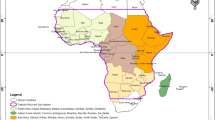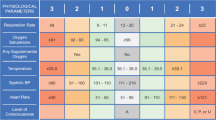Abstract
Although several factors such as cigarette smoking, blood pressure, diabetes, obesity, hypercholesterolemia, physical inactivity and dietary factors have been well documented to increase the risk for stroke, there are conflicting data about the role of meteorological variables in the etiology of stroke. We conducted a retrospective study to investigate the association between weather patterns, including daily temperature, humidity, wind speed, and air pressure, and stroke admissions to the Emergency Department of Atatürk Training and Research Hospital in Ankara, Turkey, between January 2009 and April 2010. Generalized additive models with logistic link function were used to investigate the relationship between predictors and days with and without stroke admission at lags 0–4. A total of 373 stroke patients were admitted to the emergency department (ED) between January 2009 and April 2010. Of patients, 297 had ischemic stroke (IS), 34 hemorrhagic stroke (HS), and 42 subarachnoidal hemorrhage (SAH). Although we did not find any association between overall admissions due to stroke and meteorological parameters, univariable analysis indicated that there were significantly more SAH cases on days with lower daily mean temperatures of 8.79 ± 8.75 °C as compared to relatively mild days with higher temperatures (mean temperature = 11.89 ± 7.94 °C, p = 0.021). The multivariable analysis demonstrated that admissions due to SAH increased on days with lower daily mean temperatures for the same day (lag 0; odds ratio (OR) [95 % confidence interval (95 % CI)] = 0.93 [0.89–0.98], p = 0.004) and lag 1 (OR [95 % CI] =0.76 [0.67–0.86], p = 0.001). Furthermore, the wind speed at both lag 1 (OR [95 % CI] = 1.63 [1.27–2.09], p = 0.001) and lag 3 (OR [95 % CI] = 1.43 [1.12–1.81], p = 0.004) increased admissions due to HS, respectively. In conclusion, our study demonstrated that there was an association between ED admissions due to SAH and HS and weather conditions suggesting that meteorological variables may, at least in part, play as risk factors for intracranial hemorrhages.
Similar content being viewed by others
References
Anlar O, Tombul T, Unal O, Kayan M (2002) Seasonal and environmental temperature variation in the occurrence of ischemic strokes and intracerebral hemorrhages in a Turkish adult population. Int J Neurosci 112:959–963
Beseoglu K, Hänggi D, Stummer W, Steiger HJ (2008) Dependence of subarachnoid hemorrhage on climate conditions: a systematic meteorological analysis from the Düsseldorf metropolitan area. Neurosurgery 62:1033–1038
Cowperthwaite MC, Burnett MG (2011) An analysis of admissions from 155 United States hospitals to determine the influence of weather on stroke incidence. J Clin Neurosci 18:618–623
Ebi KL, Exuzides KA, Lau E, Kelsh M, Barnston A (2004) Weather changes associated with hospitalizations for cardiovascular diseases and stroke in California, 1983–1998. Int J Biometeorol 49:48–58
Feigin VL, Nikitin YP, Bots ML, Vinogradova TE, Grobbee DE (2000) A population-based study of the associations of stroke occurrence with weather parameters in Siberia, Russia (1982–92). Eur J Neurol 7:171–178
Goggins WB, Woo J, Ho S, Chan EY, Chau PH (2012) Weather, season, and daily stroke admissions in Hong Kong. Int J Biometeorol 56:865–872
Hakan T, Kizilkilic O, Adaletli I, Karabagli H, Kocer N, Islak C (2003) Is there any seasonal influence in spontaneous bleeding of intracranial aneurysm and and/or AVM in Istanbul? Swiss Med Wkly 133:267–272
Hong YC, Rha JH, Lee JT, Ha EH, Kwon HJ, Kim H (2003) Ischemic stroke associated with decrease in temperature. Epidemiology 14:473–478
Hori A, Hashizume M, Tsuda Y, Tsukahara T, Nomiyama T (2012) Effects of weather variability and air pollutants on emergency admissions for cardiovascular and cerebrovascular diseases. Int J Environ Health Res 22:416–430
IPCC (2007) Summary for policymakers (2007). In: Parry ML, Canziani OF, Palutikof JP, van der Linden PJ, Hanson CE (eds) Climate change 2007: impacts, adaptation and vulnerability. Contribution of working group II to the fourth assessment report of the Intergovernmental Panel on Climate Change. Cambridge University Press, Cambridge, pp 7–22
Jimenez-Conde J, Ois A, Gomis M, Rodriguez-Campello A, Cuadrado-Godia E, Subirana I (2008) Weather as a trigger of stroke. Daily meteorological factors and incidence of stroke subtypes. Cerebrovasc Dis 26:348–354
Keatinge WR, Coleshaw SR, Cotter F, Mattock M, Murphy M, Chelliah R (1984) Increases in platelet and red cell counts, blood viscosity, and arterial pressure during mild surface cooling: factors in mortality from coronary and cerebral thrombosis in winter. Br Med J (Clin Res Ed) 289:1405–1408
Kyobutungi C, Grau A, Stieglbauer G, Becher H (2005) Absolute temperature, temperature changes and stroke risk: a case-crossover study. Eur J Epidemiol 20:693–698
Lejeune JP, Vinchon M, Amouyel P, Escartin T, Escartin D, Christiaens JL (1994) Association of occurrence of aneurysmal bleeding with meteorologic variations in the north of France. Stroke 25:338–341
Matsumoto M, Ishikawa S, Kajii E (2010) Cumulative effects of weather on stroke incidence: a multi-community cohort study in Japan. J Epidemiol 20:136–142
McArthur K, Dawson J, Walters M (2010) What is it with the weather and stroke? Expert Rev Neurother 10:243–249
Neild PJ, Syndercombe-Court D, Keatinge WR, Donaldson GC, Mattock M, Caunce M (1994) Cold-induced increases in erythrocyte count, plasma cholesterol and plasma fibrinogen of elderly people without a comparable rise in protein C or factor X. Clin Sci (Lond) 86:43–48
Pinkerton KE, Rom WN, Akpinar-Elci M, Balmes JR, Bayram H, Brandli O, Hollingsworth JW, Kinney PL, Margolis HG, Martin WJ, Sasser EN, Smith KR and Takaro TK (2012) on behalf of the American Thoracic Society Environmental Health Policy 9:3-8
Pinkerton KE, Rom WN, Carlsten C, Jaakkola JK, Bayram H, Sigsgaard T, Elci MA, Costa DL (2013) Climate change and global public health. Turk Toraks Derg 14:115–122
Roger VL, Go AS, Lloyd-Jones DM, Benjamin EJ, Berry JD, Borden WB et al (2012) Heart disease and stroke statistics—2012 update: a report from the American Heart Association. Circulation 125:e2–e220
Rothwell PM, Wroe SJ, Slattery J, Warlow CP (1996) Is stroke incidence related to season or temperature? Lancet 347:934–936
Vuleković P, Nikolić-Đorić E, Kojadinović Z, Papić V, Karan M, Dóczi T (2011) A temporal pattern in the occurrence of aneurysmal subarachnoid hemorrhage in the Province of Vojvodina, Serbia. Acta Neurochir (Wien) 153:1313–1319
Conflict of interest
The authors have no commercial associations or sources of support that might pose a conflict of interest.
Author information
Authors and Affiliations
Corresponding author
Rights and permissions
About this article
Cite this article
Çevik, Y., Doğan, N.Ö., Daş, M. et al. The association between weather conditions and stroke admissions in Turkey. Int J Biometeorol 59, 899–905 (2015). https://doi.org/10.1007/s00484-014-0890-9
Received:
Revised:
Accepted:
Published:
Issue Date:
DOI: https://doi.org/10.1007/s00484-014-0890-9




